|






Click the flag
Meet our special
U.S. Publishers
|
Visual
Strategies/Augmentative Communication
Back
to Autism Spectrum Disorders Booklists
Featured
Books in this Category

Featured
Books
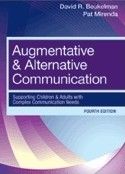
|
Augmentative & Alternative
Communication: Supporting Children and Adults with Complex Communication Needs,
4th Edition. David Beukelman
& Pat Mirenda. $93.50
As AAC use continues to flourish and new
technology revolutionizes the field, tomorrow's service providers need current,
authoritative information on AAC for children and adults with communication
disorders. That's why David Beukelman and Pat Mirenda have revised and updated
the bestselling AUGMENTATIVE AND ALTERNATIVE COMMUNICATION — the trusted,
widely adopted graduate-level text on communication disorders and AAC. The
foundational textbook for SLPs, OTs, PTs, teachers, and other professionals in
clinical and educational settings, this fourth edition is a definitive
introduction to AAC processes, interventions, and technologies that help people
best meet their daily communication needs.
Readers will get a thorough overview of
communication and AAC issues for people with specific developmental
disabilities (including cerebral palsy, intellectual disability, and
autism) and acquired disabilities (such as aphasia, traumatic brain
injury, and degenerative cognitive and linguistic disorders). And with helpful
photos, figures, and photocopiable forms, readers will be ready to collect and
use important information on assessment, individual communication needs,
classroom supports, and more. |
|
|
Autism and the iPad: Strengthening
Communication and Behavior. Brian Friedlander &
Christine Besko-Maughan, $13.95 (laminated reference guide)
Students with autism often have two primary
challenges that greatly affect their ability to learn: communication and
behavior. The iPad has revolutionized the field of education, especially for
students with ASD, due to the wide range of applications (apps) that address
language development, augmentative/alternative communication (AAC), visual
schedules, social stories, positive behavior reinforcers, and behavior data
collection. This reference guide provides valuable information on these apps,
as well as tips and strategies that will assist in promoting the successful
implementation of the iPad in the education environment. |
|
|
The Cartoon and Script Curriculum for Teaching Social
Behavior and Communication: Using Visual Strategies to Support Behavioral
Programming for Individuals with ASD. Vera Bernard-Opitz, $32.95
This easy-to-use book is designed to help children with
ASD find friends, become better communicators, increase their flexibility, and
live lives that are less stressful. Skills are presented in the form of
cartoons, scripts and role play — all evidence-based practices — that address a
wide range of developmental levels. This book breaks down complex behaviors
into manageable steps and provides methods to help children and youth
generalize skills across settings and people. The result: individuals on the
spectrum become more effective in managing everyday life. |
Back to top
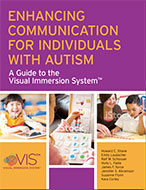
|
Enhancing Communication for Individuals with Autism: a
Guide to the Visual Immersion System. Howard Shane, Jennifer
Abramson, Kara Corley, et al, $63.95
How can you help children with moderate to severe autism
become more effective communicators? Discover the Visual Immersion System
(VIS), a practical, research-based intervention framework that taps into the
strong visual processing skills many children on the spectrum have. You'll
learn how to use readily available resources-from photos and symbols to apps
and software-to create a customized system of visual supports that boost seven
key communicative functions (see sidebar). For each of the functions, you'll
get comprehensive how-to guidance on choosing tools and materials, conducting
systematic instruction, collecting data, and assessing how well interventions
are working. A must for SLPs, interventionists, and educators, the innovative
VIS approach will ensure better communication and higher quality of life for
children with autism. Why the VIS works:
- Uses visual supports, an approach that's proven successful for
children with autism
- Strengthens communication skills needed for learning and
meaningful human interaction
- Builds on evidence-based assessment and intervention procedures
- Incorporates a wide range of low-tech and higher-tech options
- Flexible — can be used in home, school, or community settings
- Provides clear, easy-to-use instructions on conducting
interventions
- Includes guidance on generalizing new communication skills
|
|
Hygiene and Related
Behaviors for Children and Adolescents with Autism Spectrum and
Related Disorders: a Fun Curriculum with a Focus on Social Understanding.
Kelly Mahler, $29.95
Beyond
showers and tooth brushes — this fun and ready-to-use curriculum
stresses the role of perspective-taking and the social impact
of good hygiene. |
|
Interactive
Reading Books. Joan Green, Illustrated by Linda Comerford,
$33.95 each
These interactive books for children have proven to be powerful
learning aids for all beginning readers. The books are fun and rewarding
for children with and without special needs. Each book utilizes
the power of visual strategies so beginning readers can learn to
associate pictures with words. Students move and attach picture
cards with hook and loop fasteners to match, identify, label, sequence
and create sentences while learning to read.
Interactive Reading Books have six levels of activities
to work on, making them appropriate for a variety of students at
different academic achievement levels. Instructions for use appear
on the inside cover of every book.
How Many? • What Color Is It? • I Go to School •
Things I Do At Home • Action: Verbs with Who, What and Where
Questions • Sounds Good to Me: Phonics and the Alphabet •
The Ups and Downs of Opposites • How Do I Feel? An Interactive
Reading Book of Emotions
I Have Feelings Too! An Interactive Reading Book of Emotions for
Teens, Adults and Seniors • What Happened and Why: Inferences
and Reasoning Activities • Pigs in Space: Prepositions, Animals
and Rhyming Words • Who’s On First: Sequencing • Meet
the Word Family • Show Me a Sign: an Interactive Reading Book about Signs • What’s it For: Function and Categorizing
• What Do I Do: Appropriate School Behavior • What Do
I Say: Social Responses • What Do They Really Mean? An Interactive Reading
Book about Idioms
Interactive Reading Software Library 1. Joan Green,
$129.95
Interactive Reading Software Library 2. Joan Green,
$129.95
These two software discs contain all 16 books of the popular Interactive Reading Book series. The software reads the books
aloud with highlighted text and lets the student click on any word
for identification. It features picture-to-picture and picture-to-word
matching exercises with a speech recording option. Includes an easy-to-use
management system that lets you select specific books and activities
for each student to work on and stores their performance results.
Windows only. |
|
|
|
|
|
|
|
|
|
|
Back to top
|
ISPEEK
at Home: Over 1300 Visual Communication Images on CD-ROM.
Janet Dixon, $61.95
ISPEEK at School: Over 1300 Visual Communication Images
on CD-ROM. Janet Dixon, $61.95
The collection of 1300 picture symbols
on each ISPEEK CD-ROM provides easy-to-use and enjoyable
tools for overcoming communication difficulties in children with
autistic spectrum disorders. Each CD-ROM also provides useful word
templates to inspire teachers, parents and carers in putting together
daily schedules, as well as PDF samples to assist them in setting
up visual aids for children with autism, helping them to interact
better with their home or school environment. These bright, contemporary
and culturally various symbols will be a welcome communication aid
for parents, carers and other professionals working with people
on the autism spectrum at home and school.
- ISPEEK at Home contains
symbols for a wide range of situations typically encountered in
the home and beyond, from feelings and facial expressions to health,
hygiene and holidays.
- ISPEEK at School can be applied
to a wide range of situations typically encountered at school,
from social skills to school curricula, work and break times.
These are also suitable for parents and carers to use at home,
covering the important themes of transitions and independence.
|
|
|
Learning With
a Visual Brain in an Auditory World: Visual Language Strategies
for Individuals with Autism Spectrum Disorders. Ellyn Lucas
Arwood, & Carole Kaulitz, $40.95
Children diagnosed with an autism spectrum disorder
(ASD) often present parents and educators with perplexing symptoms.
Even though the skills of children with ASD can range from very
high to very low, they have similar underlying learning systems.
Knowledge about these learning systems helps provide direction for
choosing effective assessment and intervention methods for helping
individuals with ASD learn to behave, to perform academically, and
to become socially competent. |
|
Literacy for Visual Learners: Teaching Children with
Learning Differences to Read, Write, and Communicate. Adele Devine, $49.95
This book takes a fresh look at approaches to teaching
reading, writing and communication skills. It presents a wealth of innovative
ideas specifically designed to support visual learners, including those with
autism spectrum conditions and special educational needs.
Some children are more responsive to visual stimulation than spoken words, and
this book shows how to engage these children in literacy lessons by using
strategies that cover everything from the latest assistive technology to
getting creative on a limited budget. There are tips for sharing stories with
children who find it hard to sit still, supporting reluctant writers, enabling
the pre-verbal child to answer questions and helping the child who never stops
talking to develop listening skills. The strategies are supported by practical
resources, examples and case studies, to show how to instil in children the
confidence to create and share their thoughts.
This is a must-have resource for special education teachers and coordinators,
as well as speech and language therapists, looking for new strategies for
teaching literacy. |
Back to top
|
Outsmarting Explosive Behavior:
a Visual System of Support and Intervention for Individuals with
Autism Spectrum Disorders. Judy Endow, Foreword by Brenda Smith
Myles, $43.95
Outsmarting Explosive Behavior is
a visual model designed to help decrease, and in some cases
eliminate, explosive behavior. Using a train metaphor, the
parent/facilitator and student identify triggers, design positive
interventions to prevent the “anger” train
from leaving the station and preventing a car from moving further
down the line. The three-piece package contains:
- a book for facilitators that explains the model
- a large poster-size visual showing the train model with ready-made
parts that can be personalized
- a workbook for the individual with AS designed to draw out
- the personalized interventions that will make the model work.
Though designed to encourage participation by the person with
explosive behavior, positive results are seen even when the model
is implemented on behalf of someone unable to actively participate,
such as nonreaders. |
|
Picture Directions: Building
Independence Step-by-Step. Pat Crissey, $71.95
Many students can perform activities
independently by following picture directions. This reproducible book features
46 lessons divided into five categories: Cooking, Crafts, Life Skills, Play and
Discovery. Each lesson features an illustrated "You will need"
checklist plus step-by-step instructions—four to a page. Teacher Tips help you
plan your instructional strategies.
The goal of this book is to teach
students to follow picture directions in sequence, complete important
activities independently and recognize sight words paired with the
illustrations. Includes a CD-ROM with printouts. |
|
A Picture's Worth: PECS and Other
Visual Communication Strategies in Autism, 2nd Edition. Andy Bondy & Lori Frost, $26.95
A PICTURE'S WORTH is the PECS primer
written by the developers of the Picture Exchange Communication System. It
examines verbal communication development and how autism affects these skills,
and shows how a child's poor communication skills can lead to problem
behaviors. Providing communication options — PECS and the other augmentative and
alternative communication strategies (AAC) — described in the book—reduces
frustration and enhances learning.
This new edition cites research that
proves PECS (and other AAC strategies) doesn't interfere with the development
of speaking skills, and actually can provide a boost to the acquisition of
these skills. Thousands of people with autism and other disabilities have
benefited from using PECS. The book's complete set of introductory lessons
makes it easy for parents and therapists to get started using this low-tech
strategy to help young children through adults develop effective communication
skills! |
Back to top
|
Practically Speaking:
Language, Literacy, and Academic Development for Students with AAC
Needs. Edited by Gloria Soto & Carole Zangari, $44.95
When K-12 students use augmentative and alternative communication (AAC), what can SLPs and educators do to ensure the best academic and social outcomes? They'll find out in this accessible guidebook — every professional's key to helping students develop the language and literacy skills that lead to higher academic achievement and positive peer relationships. |
|
Rising to New Heights of Communication and Learning for Children with Autism. Carol Spears & Vicki Turner, $24.95
The definitive guide to using alternative-augmentative communication, visual strategies and learning supports at home and school. |
|
|
The Secrets in Their Eyes: Transforming the Lives of
People with Cognitive, Emotional, Learning, or Movement Disorders, or Autism by
Changing the Visual Software of the Brain. Melvin Kaplan, $27.95
Vision therapy techniques can correct not only visual
problems, but also cognitive, emotional and physical difficulties. Based on the
pioneering work of Dr Melvin Kaplan, this research-based book explains the
basis of vision therapy, who it can help, and the outcomes it can bring.
Visual perceptual problems can cause an array of difficulties, from reading and
writing, to issues with balance, clumsiness, and tunnel vision. Severe symptoms
can lead to a diagnosis of anxiety, depression, learning disability or even
autism. In this groundbreaking book, Dr Kaplan shows how these symptoms point
to interventions that change the way that the eyes process information,
permanently counteracting visual deficits and impacting on behaviour. Case
studies demonstrate how to plan and implement visual management programs
according to a patient's symptoms, illustrating the wide range of life-changing
results that vision therapy can achieve for people of all ages, regardless of
severity of symptoms. Dr Kaplan also shares his expert knowledge of ambient
yoked prisms - a tool that transforms light to alter visual stimulation,
dramatically transforming perception and cognition.
This accessible book presents readers — including parents and families,
clinicians, and other professionals working with individuals with visual perception
problems — with a comprehensive introduction to the benefits and methods of
vision therapy. |
Back to top
|
The Social Skills Picture Book: Teaching Play,
Emotion, and Communication to Children with Autism. Jed Baker, $51.95
Winner of an iParenting Media Award, this book uses
photographs of students engaging in a variety of real-life social situations.
The realistic format plays to the visual strengths of children with ASD to
teach appropriate social behaviors. Color photographs illustrate the
"right way" and "wrong way" to approach each situation and
the positive/negative consequences of each. A facilitator (parent, teacher,
etc.) is initially needed to explain each situation, and ask questions such as
"What is happening in this picture?" Children role-play skills until
confident enough to practice them in real-life interactions. |
|
The Social
Skills Picture Book for High School and Beyond. Jed Baker,
$54.95
The Social Skills Picture Book
for High School and Beyond offers parents and educators
of teens (and young adults) photos of actual students engaging
in a variety of social situations. This visual learning format
shows, rather than tells, students the right (and wrong)
ways to interact in different circumstances. The photos illustrate
the positive and the negative consequences of social interactions
in a wide variety of real-life situations that are important
to teens. |
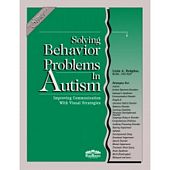
|
Solving Behavior Problems
in Autism: Improving Communication with Visual Strategies. Linda
Hodgdon, $60.95
Communication and behavior are
intertwined. Using visual strategies to improve communication can significantly
improve behavior situations. This book is packed with lots of samples and
examples of visual tools that have worked for students with autism spectrum disorders
and others with moderate to severe communication or behavior challenges —
including aphasia, brain injury, processing disorders and more. |
|
|
Teach Me with Pictures: 40 Fun Picture
Scripts to Develop Play and Communication Skills in Children on the Autism
Spectrum. Simone Griffin, Ruth Harris & Linda
Hodgdon, $35.95
An easy-to-use resource for
professionals and parents, this book provides fun and practical ideas to help
motivate and extend communication and play skills in children with autism with
the support of pictures.
The book describes how picture scripts
can help facilitate play and learning and provides 40 photocopiable scripts
across a range of different activities such as drawing, cooking, using
construction toys, imaginative play, arts and crafts, and life skills. Tasks
are presented in small manageable step-by-step picture sequences and support a
range of skills including following instructions, increasing independence,
comprehension, story-telling and choice-making. Readers can print copies of the
scripts from the CD-ROM that accompanies the book. |
Back to top
|
|
Technology Tools for Students with
Autism: Innovations that Enhance Independence and Learning. Katharine Boser, Matthew Goodwin & Sarah Wayland, $53.50
Technology holds great promise for
helping students with autism learn, communicate, and function effectively in
the modern world. Start leveraging that power today with this forward-thinking
book, your in-depth guided tour of technologies that support learners with
autism and help them fully participate in their classroom and community. You'll
learn about readily available technologies you can use right now, and explore
next-wave innovations that will help shape the future of autism intervention.
You'll also get critical guidance on how to select the appropriate technology
for your needs, weave technology into a universal design for learning
framework, and conduct effective professional development so teachers make the
most of new tools and strategies. Explore the benefits of technologies like:
- apps for education, communication, behavior
regulation, and more
- video modeling
- language processing software
- customized digital stories and book creator apps
- element cue supports
- emotional regulation and sensing technologies
- interactive learning software to improve
feedback and metacognition
- visualization and mind mapping apps
- text-to-speech and speech to text software
- e-readers and tablets with integrated multimedia
(e.g., cameras, microphones, etc.)
- electronic data collection forms for use with
handheld devices
|
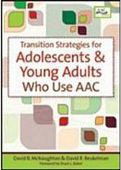
|
Transition Strategies for Adolescents
& Young Adults Who Use AAC. David McNaughton
& David Beukelman, $43.50
Combining the best research-based practices
from diverse fields — including special education, vocational rehabilitation, and
communication disorders — this essential resource covers every aspect of
transition planning for young adults with a wide range of disabilities.
Professionals will get the knowledge and strategies they need to help young
people who use AAC to make a smooth transition to a fulfilling, self-determined
adult life. |
|
Video Modeling for Young Children
with Autism Spectrum Disorders: a Practical Guide for Parents and Professionals. Sarah Murray & Brenna Noland, $27.95
Video modeling takes visual learning to
the next level by using new technologies to create an effective teaching tool.
This book explains how professionals and parents can use innovative video
modeling techniques to support the development of young children with autism
spectrum disorders in school, home or community settings.
Offering practical step-by-step
guidance, the book shows how to film and edit personalized videos that
highlight the exact skill that is being taught. Whether the focus is increasing
attention, peer interaction, getting dressed or creative play, these videos are
easy to incorporate into daily routines. They allow the child to learn new
skills quickly and with less hands-on adult support leading to greater
independence. Three video modeling strategies are presented – Basic Video
Modeling, Video Self-Modeling and Point-of-view Video Modeling – along with all
the information needed for readers to start using the techniques for
themselves. The research behind the approach is also discussed and each chapter
includes detailed case studies that demonstrate the techniques in action. |
Back to top
|
Video Modeling: Visual-Based Strategies to Help
People on the Autism Spectrum. Stephen Lockwood, $13.95
The key to helping your ASD child may be right in your
pocket! Help your child to learn new skills and overcome existing barriers
quickly and independently, regardless of age or ability. Video modeling is an
effective method of teaching that uses recorded videos and technology. With
repetitive and consistent exposure to video models, success stories include:
- A child who would not brush his teeth
- A teenager being acclimated to a new work environment
- A four-year-old who has not developed proper play-skills
- A child who would not engage with her teachers in class
- And so much more!
Learn how, using only your smartphone, to create
educational and beneficial material to help learners with autism increase
independence, facilitate learning, and improve quality of life. |
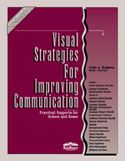
|
Visual Strategies for Improving
Communication: Practical Supports for School and Home, 2nd Edition. Linda Hodgdon, $60.95
This revised and updated edition of this
bestseller is the most comprehensive book to explain the use of visual
strategies to improve communication for students who experience moderate to
severe communication challenges. It is full of easy-to-use techniques and
strategies that will help these students participate more effectively in social
interactions and life routines. |
|
Visual Support
for Children with Autism Spectrum Disorders: Materials for Visual
Learners. Vera Bernard Opitz & Anne Häußler, $49.95
This book offers practical ideas and teaching methods for using visual supports with students with autism spectrum disorders and other visual learners. With hundreds of colorful illustrations and step-by-step directions, this book lays the foundation for how to structure teaching environments, as well as offers countless examples of activities for students, ranging from basic skills, to reading and math, to social behavior. |
Back to top
|
Visual Supports for People with Autism, 2nd
Edition: a Guide for Parents and Professionals. Marlene Cohen & Peter Gerhardt, $34.95
Visual supports — any pictorial, graphic, or scheduling
aid — are excellent tools for teaching academic, daily living, and self-help
skills to people with autism. This reader-friendly and practical book shows
teachers, parents, and service providers how to make low-tech visual supports,
and offers strategies for using them. The second edition includes expanded
information about using visual supports with the youngest children, advice on
fading supports, and updated photo examples of:
- activity schedules, calendars, charts, checklists & to-do
lists
- color coding, flip books, graphic organizers, mnemonics, nametags
- photo boards, Power Cards, scripts
- Social Stories, video modeling
A new chapter covers high-tech options for visual
supports (iPads, smartphones, etc.) and how to choose appropriate ones, and
particular features that are good for people with autism. |
|
|
Visual Supports for Visual Thinkers:
Practical Ideas for Students with Autism Spectrum Disorders and Other Special
Education Needs. Lisa Rogers, $52.95
Visual supports have been proven to be a
highly effective way to communicate with, and teach, a student with an autism
spectrum disorder or other learning difficulty. This book is packed with
simple, effective tools to assist in the education of students with special
education needs. They can be adapted to be used with young children and older
learners with a range of educational needs, including nonverbal learners. Based
on the author's years of teaching experience, the book covers how the classroom
environment is laid out, how to use schedules and time planning aids, different
education approaches and the teaching of social rules and appropriate behavior.
All the visual supports are clearly explained alongside examples and photos
showing them in use in the classroom. The supports are also included on the
accompanying CD as blank templates. |
|
Visual Thinking
Strategies for Individuals with Autism Spectrum Disorders: the Language
of Pictures. Ellyn Lucas Arwood, Carole Kaulitz & Mabel
Brown, $36.95
Visuals of all kinds (photographs, checklists, line drawings,
cartoons, flowcharts, stick figures, etc.) are commonly used as
supports for individuals on the autism spectrum who tend to think
and learn visually. However, not all visuals are created equal
and, therefore, visuals don't all work equally well. This companion
to Learning with a Visual Brain in an Auditory World helps
the reader understand how to match the developmental levels of
pictures and visuals to the developmental level of the person looking
at the visual. In this way, appropriate visuals provide the language
development for children with autism spectrum disorders. Drawing
from their experience with children and youth for decades, the
authors also show how effective communication can help reduce the
confusion and anxiety that often lead to behavioral outbursts. |
Back to top
Complete Booklist
Augmentative & Alternative Communication: Supporting
Children and Adults with Complex Communication Needs, 4th Edition. David
Beukelman & Pat Mirenda. $112.95
Autism and the iPad: Strengthening Communication and
Behavior. Brian Friedlander & Christine Besko-Maughan, $13.95 (laminated
reference guide)
The Cartoon and Script Curriculum for Teaching Social
Behavior and Communication: Using Visual Strategies to Support Behavioral
Programming for Individuals with ASD. Vera Bernard-Opitz, $32.95
Enhancing Communication for Individuals with Autism: a
Guide to the Visual Immersion System. Howard Shane, Jennifer Abramson, Kara
Corley, et al, $72.95
Hygiene and Related Behaviors for Children and
Adolescents with Autism Spectrum and Related Disorders: a Fun Curriculum with a
Focus on Social Understanding. Kelly Mahler, $29.95
Interactive Reading Books. Joan Green, Illustrated by
Linda Comerford, $33.95 each
Interactive Reading Software Library 1. Joan Green,
$129.95
Interactive Reading Software Library 2. Joan Green,
$129.95
ISPEEK at Home: Over 1300 Visual Communication Images on
CD-ROM. Janet Dixon, $61.95
ISPEEK at School: Over 1300 Visual Communication Images
on CD-ROM. Janet Dixon, $61.95
Learning with a Visual Brain in an Auditory World: Visual
Language Strategies for Individuals with Autism Spectrum Disorders. Ellyn Lucas
Arwood, & Carole Kaulitz, $40.95
Literacy for Visual Learners: Teaching Children with
Learning Differences to Read, Write, and Communicate. Adele Devine, $49.95
Making Visual Supports Work in the Home and Community:
Strategies for Individuals with Autism and Asperger Syndrome. Jennifer Savner
& Brenda Smith Myles, $26.75
Outsmarting Explosive Behavior: a Visual System of
Support and Intervention for Individuals with Autism Spectrum Disorders. Judy
Endow, Foreword by Brenda Smith Myles, $43.95
Back to top
Picture Directions: Building Independence Step by Step.
Pat Crissey, $71.95
A Picture's Worth: PECS and Other Visual Communication
Strategies in Autism, 2nd Edition. Andy Bondy & Lori Frost, $26.95
Practically Speaking: Language, Literacy, and Academic
Development for Students with AAC Needs. Edited by Gloria Soto & Carole
Zangari, $57.50
Rising to New Heights of Communication and Learning for
Children with Autism. Carol Spears & Vicki Turner, $24.95
The Secrets in Their Eyes: Transforming the Lives of
People with Cognitive, Emotional, Learning, or Movement Disorders, or Autism by
Changing the Visual Software of the Brain. Melvin Kaplan, $33.95
The Social Skills Picture Book for High School and
Beyond. Jed Baker, $54.95
The Social Skills Picture Book: Teaching Play, Emotion,
and Communication to Children with Autism. Jed Baker, $51.95
Solving Behavior Problems in Autism: Improving
Communication with Visual Strategies. Linda Hodgdon, $60.95
Teach Me with Pictures: 40 Fun Picture Scripts to Develop
Play and Communication Skills in Children on the Autism Spectrum. Simone
Griffin, Ruth Harris & Linda Hodgdon, $39.95
Technology Tools for Students with Autism: Innovations
that Enhance Independence and Learning. Katharine Boser, Matthew Goodwin &
Sarah Wayland, $53.50
Transition Strategies for Adolescents & Young Adults
Who Use AAC. David McNaughton & David Beukelman, $53.50
Video Modeling for Young Children with Autism Spectrum
Disorders: a Practical Guide for Parents and Professionals. Sarah Murray &
Brenna Noland, $27.95
Video Modeling: Visual-Based Strategies to Help People
on the Autism Spectrum. Stephen Lockwood, $13.95
Visual Recipes: a Cookbook for Non-Readers. Tabitha Orth,
$28.95
Visual Strategies for Improving Communication: Practical
Supports for School and Home, 2nd Edition. Linda Hodgdon, $60.95
Visual Support for Children with Autism Spectrum
Disorders: Materials for Visual Learners. Vera Bernard Opitz & Anne
Häußler, $49.95
Visual Supports for People with Autism, 2nd Edition: a
Guide for Parents and Professionals. Marlene Cohen & Peter Gerhardt, $34.95
Visual Supports for Visual Thinkers: Practical Ideas for Students
with Autism Spectrum Disorders and Other Special Education Needs. Lisa Rogers,
$59.95
Visual Thinking Strategies for Individuals with Autism
Spectrum Disorders: the Language of Pictures. Ellyn Lucas Arwood, Carole
Kaulitz & Mabel Brown, $36.95
Back to top

Didn't
find it...?
Not sure...?
Need a suggestion...?
There are over 10,000 titles listed on our website and more than 35,000 titles in our inventory. If you haven't found what you want on the website — and it's one of our specialties — chances are good that we carry it, or can get it for you. Just let us know what you're looking for.
Call us toll-free 1-800-209-9182
or e-mail
PARENTBOOKS
is pleased to invoice institutions. Please inquire regarding terms and
discounts. Shop in person, by phone, fax, mail or e-mail . VISA, Mastercard
and Interac are welcome. We are open from 10:30 to 6:00 Monday through Friday and from 11:00 to 5:00 on Saturday.
 All prices are in Canadian dollars
and are subject to change without notice. All prices are in Canadian dollars
and are subject to change without notice.

|